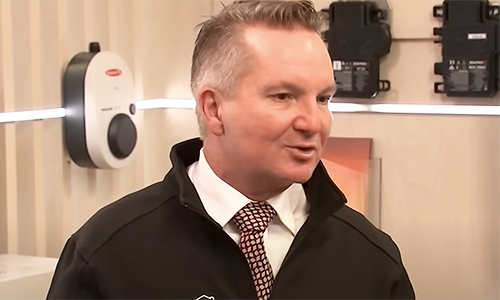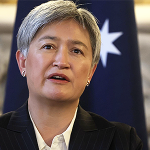
by NAZIYA ALVI RAHMAN – ENERGY Minister Chris Bowen has warned the Opposition to end division over climate policy, saying that uncertainty around net-zero was delaying the transition to green energy.
In his first announcement since being re-sworn in on May 14, Mr Bowen said Labor’s election win signalled public support for its renewable energy plan, and urged newly elected Liberal leader Sussan Ley to adopt a more constructive stance.
- Labor already implementing extremist green policy.
- Calls for Liberals to endorse Labor’s renewable energy plan.
- Household and commercial battery systems to be taxpayer subsidised.
“Trouble is, it takes two to tango,” he said. “If you’re going to review net-zero, I’m sorry, you’re keeping the climate wars going, particularly if you decide to scrap net-zero.”
Mr Bowen criticised the Coalition’s pre-election stance, which included promises to scrap four of six declared offshore wind zones, arguing it had created “sovereign risk” and caused delays in major investment decisions.
RISK
“We’ve seen offshore wind proponents saying, ‘Let’s wait and see the election result’ before deciding how they want to handle things. That sovereign risk created by Mr Dutton and Mr Littleproud was damaging,” he said.
Mr Bowen also announced that from July 1, household and commercial battery systems will become significantly cheaper under a rebate scheme introduced as part of Labor’s re-election platform.
He confirmed that battery prices would fall from nearly $9000 to just over $6000.
The program will cover battery systems ranging from 5kW to 50kW, designed to suit homes, businesses and community needs.
“We are already working on implementing that policy, which will come into force on the 1st of July,” he said.
He said the May 3 election result gave Labor a clear mandate to implement its energy policy.
“We went to the Australian people and said we have a carefully designed, appropriate policy with a mix of technologies, including gas backup, transmissions, storage, household, community and grid-scale, to get to 82 per cent renewables by 2030,” he said.
He added that the policy had been central to Labor’s campaign in key marginal seats across the country.
“We were very pleased with the results in those key marginal seats, and we intend to implement the policy we took to the people,” he said.
Bowen also defended the continued use of gas as a vital part of Australia’s energy mix, citing its flexibility and backup capacity for renewables.
He said unlike coal or nuclear power, a gas-fired power station is flexible.
“It can be turned off during the day when we’ve got all these wonderful products working well and it can be turned on if we need to at night and it can be turned off again very quickly,” he said.
HYDROGEN
He added gas continues to support heavy industry and heats five million Australian homes. With green hydrogen not yet commercial, a steady gas policy remained essential.
“We will continue with our evidence-based policy, carefully calibrated, moderate policy of ensuring that ongoing role for gas in the system and, you know, we’ll continue to review the effectiveness of the policies that we have in place and to do more if necessary,” he said.
Bowen reaffirmed Labor’s election promise to deliver six offshore wind zones.
The six declared offshore wind zones include Gippsland (Victoria), the Hunter and Illawarra regions (NSW), the Southern Ocean off Victoria, the Bass Strait off northern Tasmania and the Indian Ocean off Bunbury in Western Australia.
“We’ll continue to implement the policy, including issuing licences where appropriate within the six zones, in keeping with the plan I outlined pre-election,” he said.
On Australia’s updated 2035 emissions reduction target, Bowen said he is awaiting advice from the Climate Change Authority (CCA). Any new goal would be released after Cabinet deliberation.
Preliminary recommendations from the CCA recommend a target of 65-75 percent below 2005 levels by 2035 to stay in line with the Paris Agreement’s 1.5°C goal.
A less ambitious 2°C pathway would require at least a 57 per cent cut.
“Most countries around the world haven’t released their 2035 target yet. Of course, people will before COP30,” he said.PC











CLIMATE CHANGE CLAIMS SHOT TO PIECES.
When the Ice Cracks: Michael Mann’s Legal Defeat and the Climate of Accountability – PJ Media
What was once billed as a victory for climate science now reads like a cautionary tale of arrogance.
The End of the SLAPP Era?
Strategic Lawsuits Against Public Participation, or SLAPP suits, are designed to silence critics through legal intimidation. Mann’s campaign was a textbook example. By targeting individual writers and nonprofit think tanks, he hoped to scare others into silence.
For years, it worked. Journalists walked on eggshells. Scientists who questioned prevailing models did so anonymously or not at all. Free speech took a back seat to narrative control.
This ruling shatters that dynamic. It affirms that even loud, politically favored scientists must prove their claims with facts, not feelings. And it reminds us that courts are not the proper venue for science to settle scores.
The Ice Beneath Climate Orthodoxy Begins to Crack
The implications of this case stretch far beyond Mann’s personal disgrace. For years, the climate industrial complex has leaned heavily on scare graphs and dramatic modeling to demand trillions in global policy changes. But when one of the movement’s most famous architects is caught misrepresenting data and himself, the entire foundation begins to quake.
Organizations such as NASA, GISS, and NOAA have routinely adjusted historical temperature records and used model projections that have consistently overshot reality. Now, people are asking hard questions:
Why do projections from twenty years ago still not match observed warming?
Why are climate models consistently wrong, and why are they still used to justify sweeping regulations?
Why do scientists who challenge these inconsistencies find themselves blacklisted or defunded?
The answer is uncomfortable. For too long, one version of the science was protected by the media, bureaucracy, and legal threats. Not anymore.
The Movement Will Suffer from Its Martyr’s Fall
Michael Mann was a pillar of the climate change movement, not because his data was flawless, but because he fought like a political operative. He understood that the public didn’t need nuance; it needed symbols, and he made himself one.
His downfall represents more than just personal embarrassment. It’s an unmasking. It shows that the high priests of climate change are not always guardians of truth, but often zealots of ideology.
This could mark the start of a long-overdue audit, not just of Mann’s work, but of all the organizations that parroted his claims without question. Governments are waking up. The UK has scaled back its net-zero goals. Australia’s opposition is openly questioning climate funding. Even Germany, the gold standard of green virtue, is facing backlash over rising energy costs.
The spell is breaking.
A New Climate of Courage
Michael Mann’s courtroom humiliation is more than just a procedural win for CEI or National Review. It’s a cultural moment, a signal that free inquiry and rigorous debate are returning to climate science.
It should have always been about the data. Instead, it became about dogma. But now, people see that those who scream the loudest for consensus often have the most to hide.
To the skeptics, engineers, meteorologists, and even the farmers who questioned the gospel and paid the price, your vindication has begun.
https://pjmedia.com/david-manney/2025/05/24/when-the-ice-cracks-michael-manns-legal-defeat-and-the-climate-of-accountability-n4940123
the trouble with these clueless political types, is they force these projects to happen, even when the feasibility study says it’s going to cost so many billion, never mind the taxpayer will pay for it and the concessions for power when it doesn’t work, maybe the FS picked up it was not a good wind location, so you are stuck with a dud for the life of the wind mill farm. I think the modelling will show once replaceables get above 50% of the mix, the cost of Electricity shoots up, you get to a point where the baseload needed or batteries starts to really grow in cost to support what has a low capacity factor. I think Solar is like 20% capacity factor and wind is not much higher. It’s like a 6 lane highway that sees peak traffic for 3mins a day and then 2 lanes is sufficient.
Obviously not as intelligent as Bowen,how long has renewables & net zero been going now & yet I’m paying more now for my electricity & gas than I did in 60’s70’s 80’s when we were one of the cheapest on the planet with our coal & gas
Because the whole man-made global warming scare is a total scam all the wind and solar farms despoiling food growing land, wildlife habitats and stunning scenery, and all electric vehicles, batteries and thousands of kilometres of additional transmission lines with towers every half km are a complete waste of effort and above all our money.